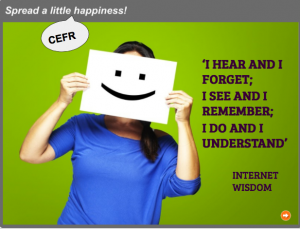I’m back from an inspirational few days at the IATEFL Conference in Birmingham and ready to report on my own workshop ‘The Gap between Classroom and Online Learning – Closing the Circle’ which took place on Saturday, the final day.
The workshop looked at the Common European Framework of Reference and ways in which its descriptors can be used to link online activities to classroom tasks. The topics that interest me most at the moment, as well as all things tech, are task-based learning and communicative language teaching. The latter has been keeping me awake at night since I heard Bill Vanpatten say (controversially) that most language programmes ‘may claim to be communicative, but they really aren’t, and they never have been.’ (SLA Podcast: Tea with BVP, episode 1)
Vanpatten says that without a valid definition of communication we can’t understand what communication is. His preferred definition is ‘communication is the expression, interpretation, and negotiation of meaning in a given context.’ What I took away from that podcast was that not all pairwork is necessarily communicative, and communicative tasks should always have a purpose. This led me to analyse what I was doing with authentic materials in class and I realised that I was relying heavily on comprehension questions or tasks that involved students sharing their opinions, but not a lot else.
So I turned to the CEFR, or rather returned, as we have an on-again, off-again love affair. From giving training courses on the CEFR, I know that many teachers are not really familiar with the descriptors. They may know the global scale or the self-assessment grid, but not much else. So my goal was to get people thinking about how they could take advantage of the CEFR to create their own lessons, particularly tasks built around online materials.
I used modules from telc’s English Practice Material Online B1-B2 to create a variety of communicative tasks.
So here’s my summary…
When it comes to using blended learning or self-study materials as homework, many teachers worry that students won’t actually do the activities. If this happens, it can be very de-motivating and can disrupt the entire lesson plan. If it happens a few times, the teacher might soon decide that the ‘tech’ experiment just isn’t worth the effort.

To ensure that students carry out the online work we set them, we need to create a stronger link between online activities and the classroom. Instead of ending our lesson with the instruction to go online and do task X for homework, we need to take the process full circle. To do this we can add a pre-task to spark interest and motivation and then follow-up tasks to build on what was done online. This shows students that online homework is not just ‘busy work’ but essential to progress. If they don’t complete the tasks, they are at a disadvantage in the face to face lesson.
You might think this is obvious, but because online learning materials are created for self-study, giving immediate feedback, we tend to think ‘they did the task, we can move on’. But then we miss out on an opportunity to really knit the course together. We want to make sure that students see it as one course, rather than two parallel streams that are loosely linked, with the second stream being less important, or possibly optional.
We could take the online material and check comprehension or vocabulary, ask for opinions or predictions, but these are things we already do. The CEFR, with its action-oriented, communicative approach, can help us come up with creative tasks that are communicative, personalised and appropriate.

In the workshop, we looked at modules from telc’s English Practice Material Online B1-B2. Here is what we did with a module from the unit Gratitude, involving a radio show where listeners rang in and spoke about the people who made a difference to their lives. To create some follow-up tasks, we first used the descriptors for Correspondence.
| Correspondence |
| B2 Can write letters conveying degrees of emotion and highlighting the personal significance of events and experiences and commenting on the correspondent’s news and views. |
| B1 Can write personal letters giving news and expressing thoughts about abstract or cultural topics such as music, films. Can write personal letters describing experiences, feelings and events in some detail. |
Using these and the idea of Gratitude, International Thank You Day (the topic of the listening activity) and the person you are grateful to, you could come up with a task like this:
‘It’s International Thank You Day, the day we are reminded to thank those who’ve helped us and made a difference in our lives.’
Who would you like to say a special thanks to? Why? Take a minute to think about your answer, then tell your partner. Write an email to a special person for International Thank You Day.
‘Happy International Thank You Day! I’m sending you this email to say thank you.’
Explain why you want to thank them. You can write about some experiences you’ve shared, where you both first met, or how you felt when they helped you out or supported you.
I have highlighted the words that link directly back to the CEFR descriptor, to show that the task really focuses on what the CEFR says students at those levels should be doing.
What can you do with the finished emails? Note the descriptor for B2 mentions commenting on the correspondent’s news and views. B2 students could be given a new email at random, and asked to read and respond in character.
Other ideas participants came up with included composing letters to thank specific people, designing thank you cards for family and friends, writing facebook posts and even a song about gratitude.
But to be honest, that one was kind of easy, so I decided to try something more challenging. I asked the participants to match the topic of gratitude to two other descriptors that were not as obvious as perhaps correspondence was.
| SUSTAINED MONOLOGUE: Describing Experience | INFORMAL DISCUSSION (WITH FRIENDS) |
| B2 Can give clear, detailed descriptions on a wide range of subjects related to his field of interest. | B2 Can take an active part in informal discussion… commenting, putting point of view clearly, evaluating alternative proposals and making and responding to hypotheses. |
| B1 Can reasonably fluently relate a straightforward narrative or description as a linear sequence of points. Can give detailed accounts of experiences, describing feelings and reactions. | B1 Can make his/her opinions and reactions understood as regards solutions to problems or practical questions of where to go, what to do, how to organise an event (e.g. an outing). |
What would you come up with?
For Sustained Monologue, I suggested a task based on a speech at your best friend’s wedding or birthday party and for Informal Discussion, a task that focuses on planning a surprise party for your best friend.
Other ideas for Sustained Monologue from the participants included having students create their own radio show talking about people who were special to them at different points in their lives, giving a thank you speech at an award ceremony, and presenting a Pecha Kucha on the topic of gratitude. For Informal Discussion, the radio show idea again, but this time as a dialogue or interview, a discussion about who to award a prize to, or which song expressing gratitude you would choose as you theme tune. Other ideas were informal discussions to decide on the best birthday gift for a mutual friend, or to plan a day out for a friend who’s feeling a bit down. I was delighted by the participants’ enthusiasm. Their suggestions were really creative and would definitely make exciting communicative lessons.
We looked at other modules and came up with lots of great ideas and hopefully I achieved my goal of sharing my love of the CEFR. Not only can it help students assess their abilities, it can also be used by teachers as a tool for planning a course, creating lessons and as in the case here, designing communicative tasks to use with online materials.
What should we do with these descriptors? I ended with my workshop with a challenge…
- Look at the descriptors with students in class to identify some key areas students wish to work on. Use those descriptors when planning your lessons.
- Assign descriptor/s at random to each of the units in your coursebook. Try to integrate these descriptors when planning.
- Find interesting content online. Use the CEFR descriptors to design action-oriented tasks to link the online material to classroom learning.
What will you do?

Resources:
http://www.teawithbvp.com
How to use telc English Practice Material Online : watch this youtube video. https://youtu.be/QBa2JtDRxZY
Eaquals Bank of Descriptions as Levels https://www.eaquals.org/resources/revision-and-refinement-of-cefr-descriptors/
The CEFR handbook


Cracking post, Laura. I do kind of like CEFR even in Japan. Anyway, that’s not why I’m here.
The way a lot of Ed-tech is used boils my pee because it’s often a bell or whistle or a massive case of fannying about with multiple choice gap fills (the likelihood being that those words might not be what a learner might have picked as the option themselves) and, like you say, class time rather than self access is devoted to it. I know you have good ideas about use of tech; it’s not yours I bemoan.
I feel the act of teaching is being looked down upon as old fashioned in some quarters. Knowing learners and reacting to their learning to scaffold it further, extending schemata, this should be done. What is essentially a page of Murphy with radio buttons and an automated score should only be homework assigned by stretched teachers at best. Practice makes perfect. Endless uncommunicative multiple-choice gap fills makes perfect multiple-choice gap fillers.
Thanks for contributing, Marc! You bring up a lot of good points.
Are you familiar with the SAMR model (Substitution, Augmentation, Modification and Redefinition) which acts as a guideline for teachers using technology? The types of tasks you mention belong to the lower levels – a page of grammar tasks made digital is essentially the same as doing the task on paper, but perhaps has the added advantage that students don’t need to wait for the class to finish to see how they did, or the teacher may get data that shows whether individual students have grasped the concept.
My view of technology is that it’s a tool which allows students take on the role of ‘maker’ and as they work to create something, learning happens. So I would be aiming at Modification (tech allows for significant task redesign) or Redefinition (tech allows for the creation of a new task, previously inconceivable). But I am fortunate that I teach small groups of adults or university students, have no pressure to prepare people for exams and I can set my own curriculum.
I definitely agree with your last sentence, it’s one of the reasons I use the CEFR so frequently.
Yet if a teacher could set students quality, engaging self-study materials for homework and free up the whole class period for (wild, noisy) practice and experimentation, I think then the gap-fill style tasks might serve a purpose.
What do you think? 🙂
Possibly, using polling software, gap fills might be OK, but I’d be keener on something like a few function drills to tidy up some of the more striking communication errors.